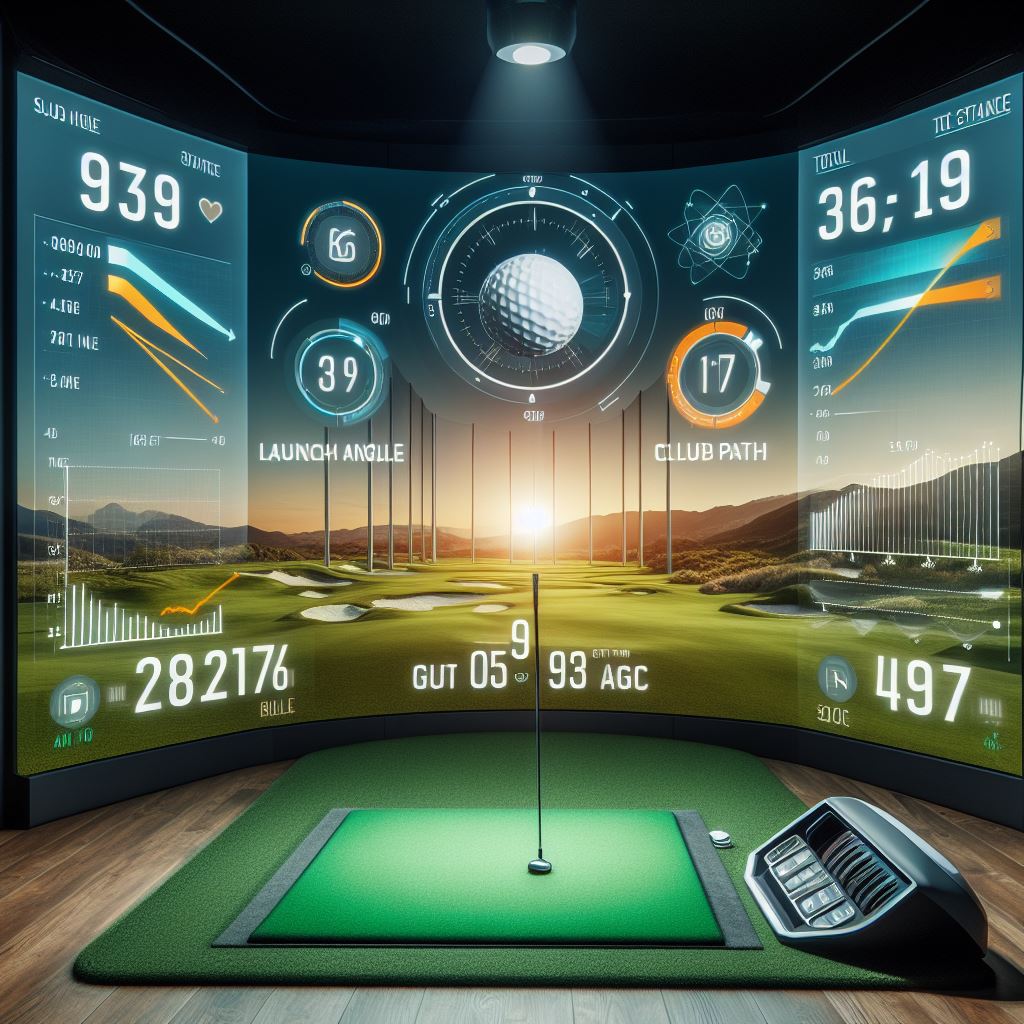Welcome to Launch Monitor Data for Beginners 101. So, you just bought a fancy high-tech launch monitor, and now it is throwing at you a whole bunch of numbers that have you thinking you are back in math class. What’s a spin axis, dynamic loft, you probably can only imagine what smash factor is referring to! Let me reassure you they are all golf-related, and they are all designed to help you improve your golf swing.
I promise, by the end, you’ll fully get what each metric means, and more importantly, you’ll understand which are most important for a beginner. You will know how to translate the numbers to understand the flaws in your swing, and where you will need to improve. Pull up a chair, class is now in session.
Launch Monitor Data For Beginners: Distance
What Is Total Distance?
Let’s start with the easiest metric to understand, total distance. It is exactly as it reads, it measures how far the ball travels from where you hit it to where it stops. It considers both the air travel and the roll it gets after landing. Total distance looks at things like how fast you swing, the angle you launch the ball, and how much it spins. Don’t worry about those right now, we will get to those later.
Total distance is the equivalent of the question of “how much do you bench” in the golf world. It is a total flex to your friends, for the pure ego boost. Don’t worry we all exaggerate what our real numbers are to look better around friends. What is important to take away is that it is a baseline metric to see if the mechanics of your swing have improved to allow the ball to travel further. Distance is certainly not everything, but for some clubs like our driver, we want to be able to maximize that number.
What Is Carry Distance?
Carry distance is how far the golf ball goes through the air from the time you hit it until it touches the ground for the first time. Forget about what happens after it lands; we’re just looking at that initial flight. Why does it matter? Well, it’s important to hit the right spots on the course and pick the right club. Your carry distance shows how strong and consistent your swing is.
Understanding carry distance can be a game-changer for your swing. When you know how far your shots carry, you’re not just swinging blindly. This is especially important for your short irons, and approach shots.. You want to know where to land the ball to get on the green. If your total distance is 150 to the pin, you want to hit it 140 yards carry, and then let it roll up to the hole. Hitting it 150-yard carry will likely put you over and off the green. So, knowing your carry is very important for your irons.
To show the difference between total distance and carry distance, let’s look at this table:
| Total Distance | Carry Distance | |
|---|---|---|
| Example Distance | 250 yards | 230 yards |
| Explanation | The ball traveled 250 yards from the point of impact until it came to rest, including both the carry and roll distances. | The ball carried 230 yards through the air from the point of impact until it first made contact with the ground. |
Launch Monitor Data For Beginners: Speed

What Is Ball Speed?
Ball speed is how fast the golf ball comes off your clubface when you hit it. This speed depends on a few things, like how fast you swing, the technology in your club, and how well you compress the ball at impact. Faster ball speed means, more distance, see Chapter One above.
If you want more distance, working on increasing your ball speed is an important metric. But it’s not just about going faster; it’s about finding that sweet spot where you’re powerful and in control. Do not sacrifice control for speed. What good is a fastball that is 50 yards deep in the trees? Establish control and direction, and then ramp up the ball speed.
What Is Swing Speed?
Swing speed is how fast your golf club is moving right before it hits the ball. This speed shows how much power you’re putting into your swing and affects how far and where the ball goes. The faster your swing, the more energy gets transferred to the ball. And guess what? That affects how far the ball travels through the air and where it ends up.
Like ball speed, It’s not just about swinging as hard as you can to get the highest number in this category. This is not the carnival and you aren’t swinging a sledgehammer to see how high you can get this number. Golf is more about precision than speed, so even though it is tempting to swing out of your shoes to get your swing speed up, stay in control. Try to get this number consistent, and hit that mark. If you are finding you are above your average, it likely means you are over-swinging.
What Is Club Head Speed?
Club head speed is how fast the head of your club is moving at ball impact. Is it an important factor it can be, is it a more important metric than swing, and ball speed no. What you need to understand with launch monitor metrics, is there are a lot of very useful metrics for beginners, and there are a lot of metrics that make the data just more complicated to someone starting. I am not saying it is not important, I am saying as a beginner in terms of speed metrics focus on swing, and ball speed first.
Launch Monitor Data For Beginners: Club Path and Angles
Club path and angles play a crucial role in understanding the direction and accuracy of your shots. By analyzing these measurements, you can gain valuable insights into your swing mechanics and identify areas for improvement in your technique.
What Is Club/Swing Path?
The club path or swing path is the direction your club is coming into the ball before impact. In an ideal world, your club path would be zero. That is the number you are shooting for, don’t worry if it is not, if it is would be on the PGA Tour, and not reading a beginner’s guide.
What you want to see is if you are consistently showing a positive (into out path), or a negative number (out to in). This number plays an extremely important role in determining the curve of your ball. If you’re someone who slices the ball you will likely always see a negative number in the club path, and if you hook it you will likely see a consistent positive number in the swing path.
How Swing Path Causes You To Slice
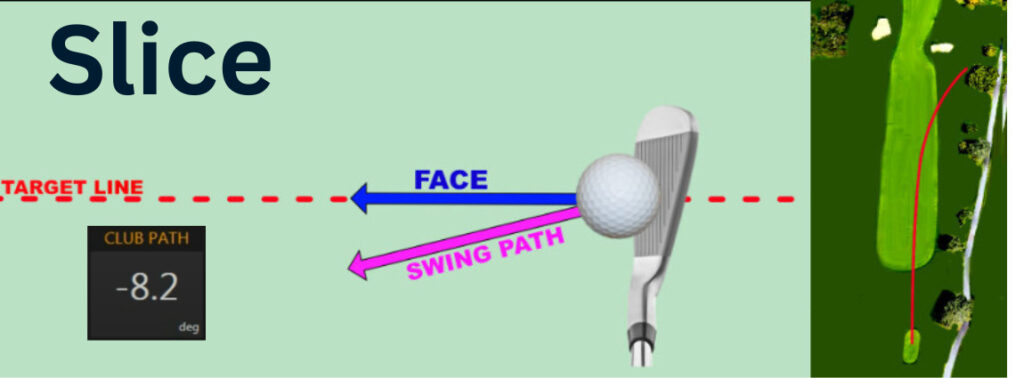
A slice is caused by a face that is open to the swing path. As you see from the diagram even if your face was completely square at impact, and your swing path was out to in (negative club path number), your ball will slice. If your face is open to the target line, and the swing path is out to in, then you are going to have a big slice. If you are suffering from a slice, and you see that consistent big negative club path number you will want to work on trying to get that number closer to zero.
How Swing Path Causes You To Hook
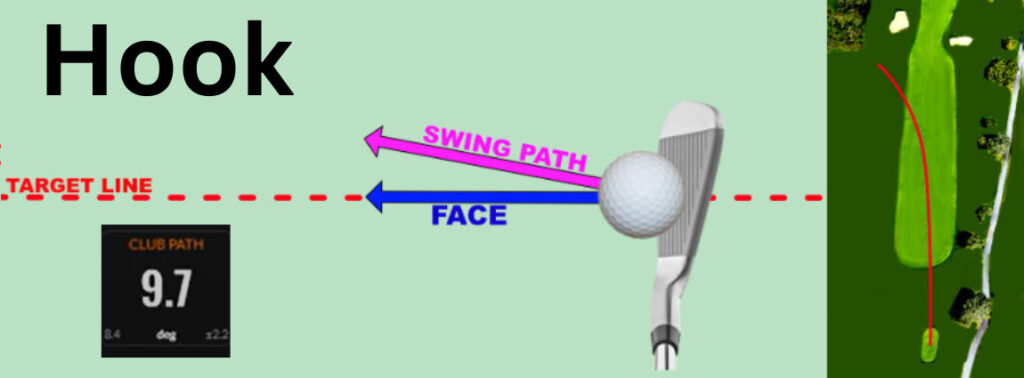
A hook is caused by a face that is closed to the swing path. As you see from the diagram, even if your face was completely square at impact, and your swing path was in to out (negative club path number) it would cause a hook curve. If your face is close to the target line, you are going to have a big hook to the left. So if you are suffering from a hook, and you see that consistent big positive club path number you will want to work on trying to get that number closer to zero.
What is Club Face Angle?
A club face angle is a number that tells you what direction the club of your face is pointing at impact. Resulting in either a club face that is considered open or closed. A positive number will mean your club face is open, while a negative number will indicate a closed face. The optimal goal is to get this number as close to zero as possible. A big number on either end will cause different types of missed shots.
Open Club Face
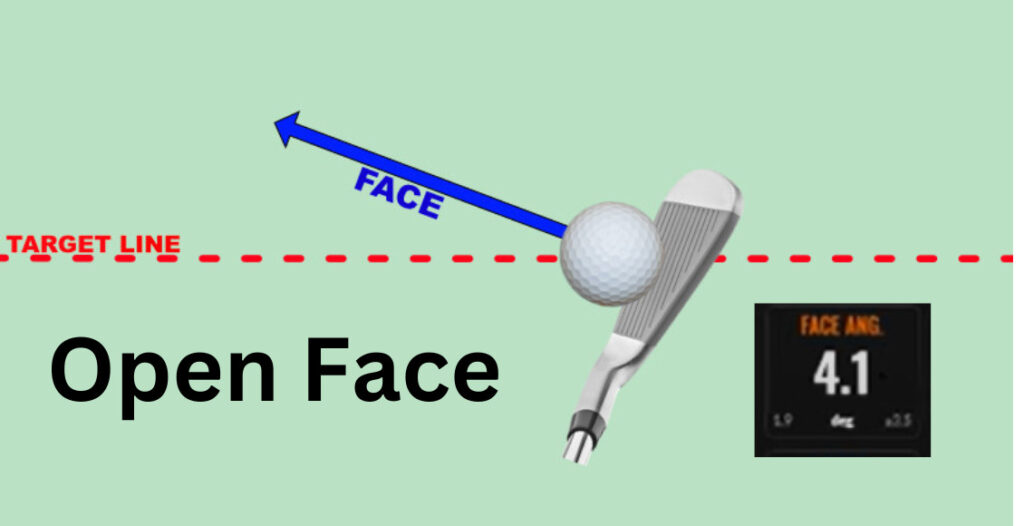
An open club face will cause one of two misses for you. If you have an in-to-out club path then your club face and club path will match and cause a straight shot with no curve, but goes right. This miss is generally called a push.
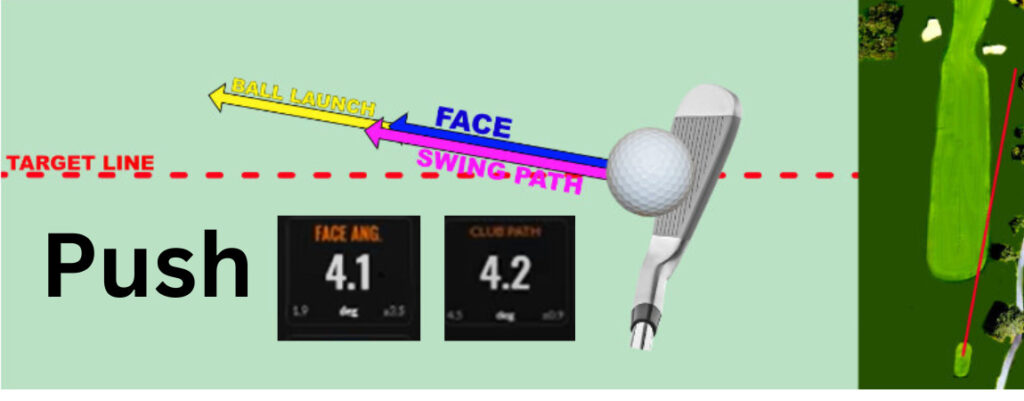
The other miss would be that big slice I mentioned before where now there is a large gap between the club path and face.
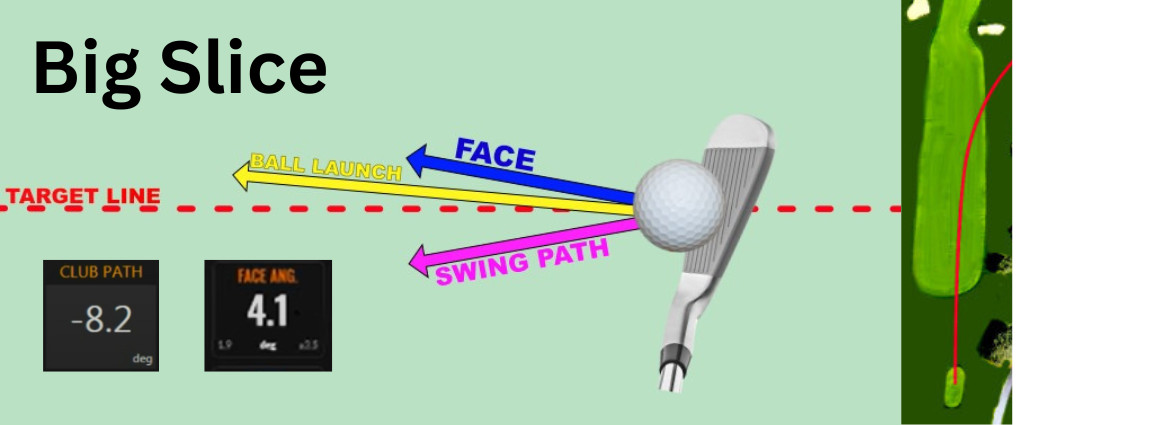
Closed Club Face
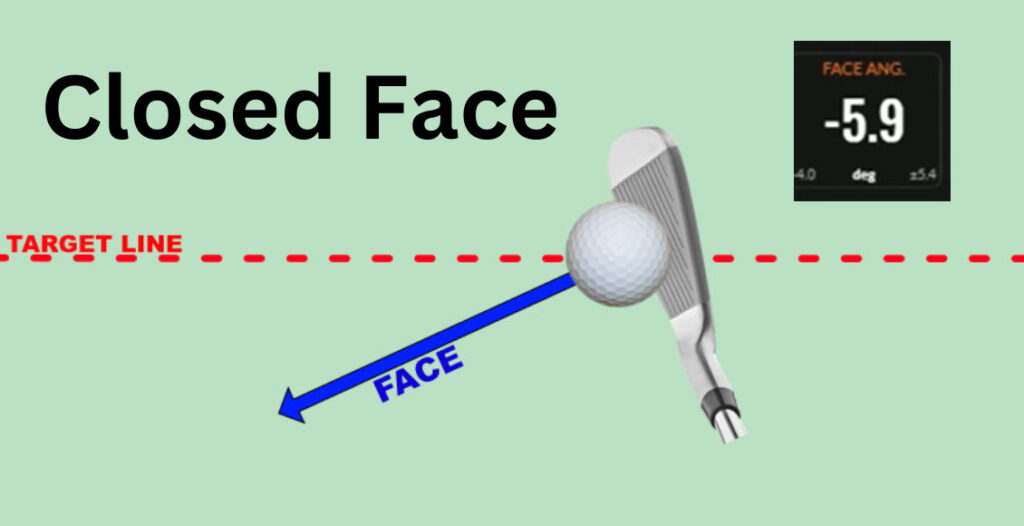
A closed club face will cause one of two misses for you. If you have an out-to-in club path then your club face and club path will match and cause a straight shot with no curve, but goes left. This miss is generally called a pull.
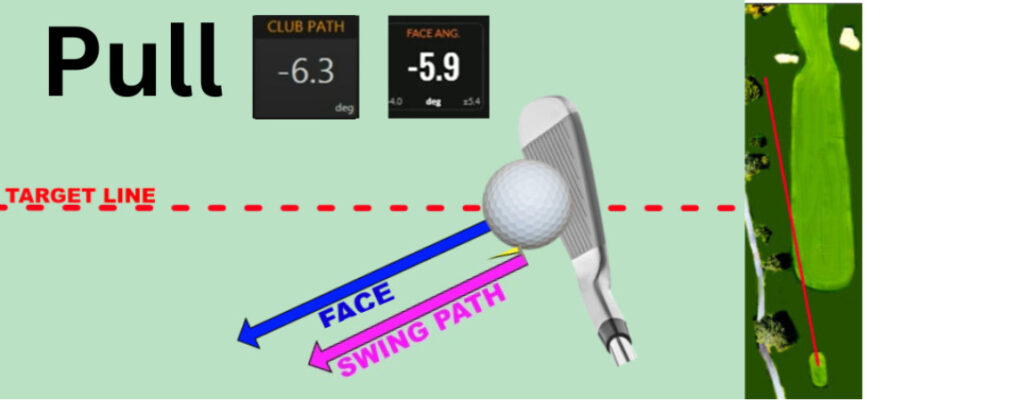
The other miss would be that big hook I mentioned before where now there is a large gap between the club path and face.

What is Face to Path?

Face to Path is the difference between where your clubface is pointing and the direction of your club path. To easily illustrate it in the above diagram the space in white would be the face-to-path metric. The larger this gap is the more curve the ball will have.
Now understand that you can have a face-to-path at zero, and still hit a shot that goes way left, or way right. If you had a -8 club path and a -8 face angle, your face-to-path would be a perfect zero, but all that means is you are hitting a perfectly straight pull shot left. If you had an 8 club path and an 8 face angle, again your face-to-path would be zero, but you would have a straight push shot to the right.
To achieve a perfectly straight shot down the middle of the fairway you would need the face angle, and club path to be zero, and as such the face to the path would also be zero because there is no gap between those other two measurements.
So all you have to do to hit a perfectly straight shot is have perfect metrics in club path, and face angle. Easy right, I guess this game is hard for a reason.
What Is Launch Angle?
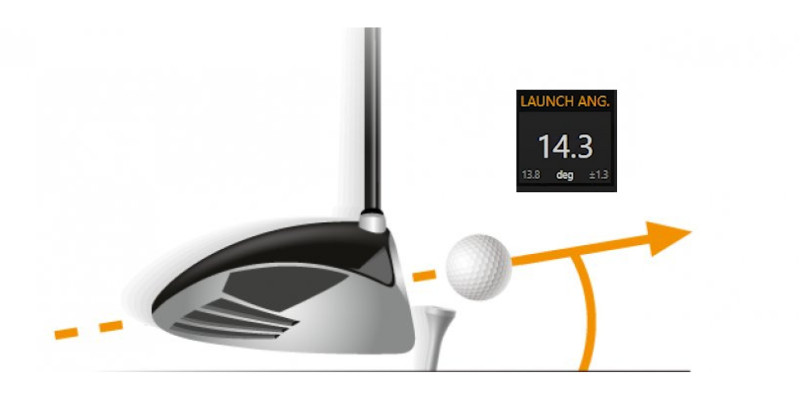
Launch angle is the angle at which the ball takes off from the clubface compared to the ground. Why does this matter? Well, it decides how high or low your ball flies and how far it goes. If you hit with a higher launch angle, your ball usually goes up higher in the air and travels a bit farther. On the flip side, a lower launch angle means your ball takes a lower path.
When hitting a driver you want to get that ball up in the air to maximize carry distance, but you also don’t want to hit too high and have these big balloon shots that go way up the air but travel no distance. The optimal launch angle for a driver is between 12 and 16 degrees. For irons it will depend on what club you are hitting mid-irons (like a 5 or 6 iron) should have a launch angle in the range of 18 to 22 degrees, while for an 8 iron and above you are looking at launch angles between 20 to 25 degrees.
What Is Angle of Attack?
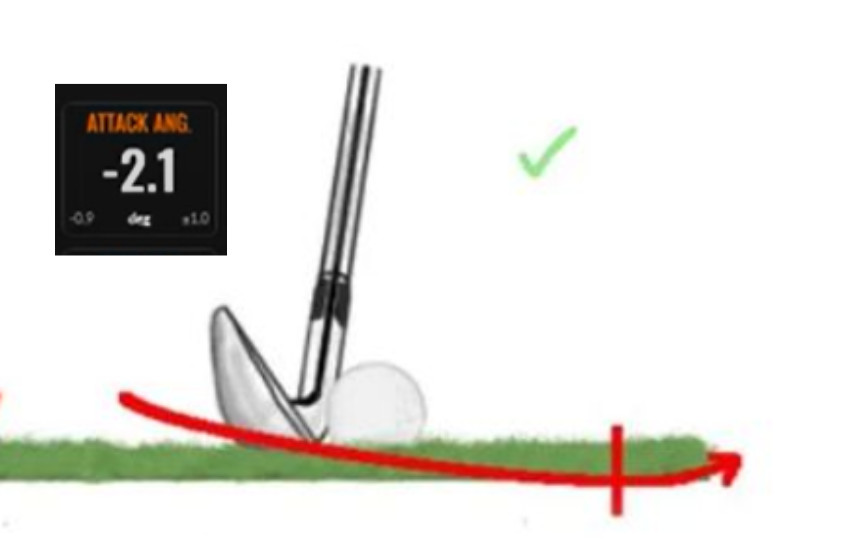
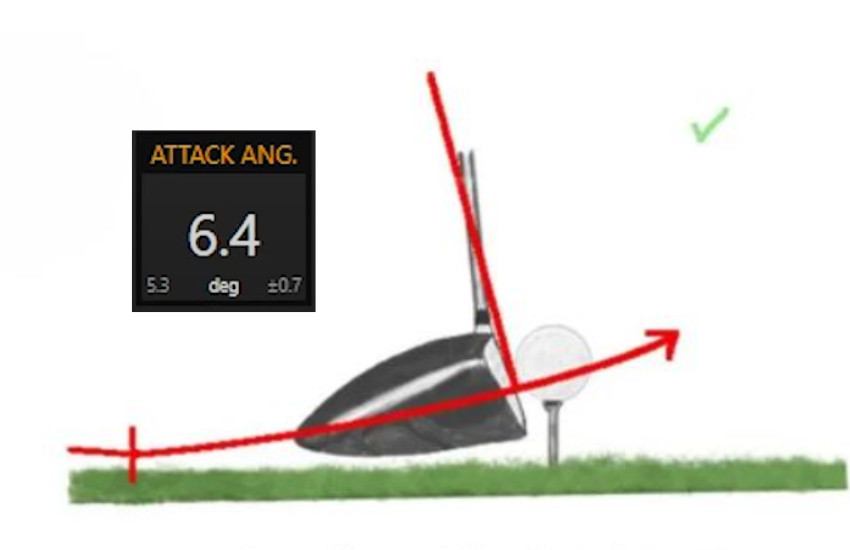
The angle of attack is the angle your clubhead hits the ball in comparison to the ground. This angle decides if you’re hitting the ball on a downward slope, or on an upward slope. And why does this matter? The angle of attack affects how much the ball spins, how high it goes, and how far it travels.
The general rule of thumb is we want to hit down on our irons to get full compression of the ball, and we want to hit up with our driver to get the ball flying in the air for maximum distance. As a beginner that is as far as I would look at the angle of attack to help you improve to start.
Launch Monitor Data For Beginners: Spin

In golf, spin refers to the movement of the golf ball that makes it rise higher in the air. or spin left to right. Let’s have a deeper dive into the effects of spin on a golf ball.
What Is Back Spin?
Backspin on a golf ball refers to the backward rotation of the ball as it travels through the air. This backspin is important for getting the ball in the air and increasing the distance of the shot.
When you hit the ball with backspin it acts like the wings of an airplane. This lift fights against gravity, making the ball stay up in the air for a longer time. With the combination of backspin and lift, the ball can cover more distance. Backspin also makes the ball land softer, reducing how much it rolls after hitting the ground.
For backspin, you want to pay attention to the number when using two types of clubs, driver and wedges. For drivers, you want between 2,000 to 3,000 rotations per minute (rpm). With a wedge, you want between 7,000 to 10,000 revolutions per minute (rpm) or even higher, depending on the specific wedge.
As a beginner, you want to use these as the general benchmark. I would only really focus on it if you are having trouble with your driver ball flight going too high, or not high enough, or b. not getting your approach shots high enough in the air.
What Is Side Spin?
Side spin is what makes the golf ball curve left or right in the air. If you are hitting a hook or slice, then you will likely have a lot of sidespin. Side spin is caused by what we discussed earlier, the swing-to-club face difference. The higher the face-to-path metric, the more side spin your ball is going to have.
For beginners, I would ignore looking at side spin. If you are hooking or slicing you don’t need a number to tell you how much you are, you can visually see it. Also to understand why you are slicing the metrics of club path, face angle, and face to path are a far better metric to explain to you why you are hitting a slice or hook. You don’t need to focus on the raw number of spins produced as a beginner.
What Is Spin Rate?
The spin rate on a launch monitor is a measure of how fast the golf ball is spinning around its axis after being struck by the club. It’s like a speedometer for the spin of the ball. A higher spin rate usually means more backspin or side spin.
Chalk this up as another metric that for a beginner I would not worry about. At this stage of your golfing journey, a deep dive into your spin rate will only complicate things more for you. There are key metrics to focus on when you are starting this is not one of them.
What Is Spin Axis?
In simple terms, the spin axis in golf refers to the axis around which the golf ball is spinning. A positive number means the spin axis is tilted to the right (causing a slice for right-handed golfers), while a negative number means the ball is tilted to the left (causing a draw or hook). Think of it like the wings of an airplane. if the wings tilt, the plane moves in the same direction. Similarly, the tilt of the spin axis affects the ball’s curve in flight.
Another one to skip. It is simply a metric that for a beginner is not going to help you. It will get you jumbled with too many numbers. Focusing on the wrong data, and trying to take it all in is too overwhelming for a beginner, just focus on the data that will be most beneficial.
Launch Monitor Data For Beginners: Other Data Points
In addition to distance, speed, club path, and spin, launch monitors provide other valuable data points that can provide valuable insights into your swing mechanics. Two important data points to consider are dynamic loft and smash factor.
What Is Dynamic Loft?
Dynamic loft measures the actual loft that the clubface gives to the ball at the exact moment they meet. Too much dynamic loft will send the ball too high, whereas you guessed it too little will have it coming out low.
Dynamic loft is a measurement that will vary depending on each player so pinpointing the optimal numbers is not easy. As such it is not a number a beginner should not be focusing on too much. Use your eyes, to see if the ball is traveling too high, or coming out too low. If it is then your dynamic loft might merit a deeper dive. For now, my opinion is that it is not a number you should be spending too much time looking at.
What Is Smash Factor?

Smash factor is easily the coolest name for a metric on a launch monitor, but it doesn’t mean exactly what you probably think it does. The smash factor measures how efficiently you’re transferring energy from your club to the ball by looking at the ratio of ball speed to club speed. Think of it as a gold star rating from your launch monitor to let you know how efficient your swing is.
What would be a 5-star gold rating you ask? well, that would be anything at 1.50 or higher. This means that for a 100 mph club speed, the ball speed would be 150 mph. If your smash factor is close to 1.50 it means you are producing the optimal ball speed for the swing speed you are producing.
This is a really good metric for beginners because it is tailored to you. It takes into account your swing speed and calculates based on that how fast your ball should go. It is measuring the efficiency of your swing, and seeing how much meat on the bone you are leaving.
Conclusion
Launch monitor data for beginners can be confusing when you are trying to look at all the numbers at once, and trying to understand what it all means.
The key is knowing the important metrics to focus on as a beginner, and which can be ignored to start. For a new golfer using a launch monitor, you want to focus on the club path, face angle, and face-to-path. In my opinion, these are the three most important metrics for a beginner golfer.
I hope this simple guide has given you a better understanding of the data a launch monitor produces, and the terms defining these numbers. Now it’s time to take that knowledge, and make improvements to your golf swing, good luck!
Disclosure: When you purchase through my affiliate links on my site, I may earn a commission. As an Amazon Associate I earn from qualifying purchases

